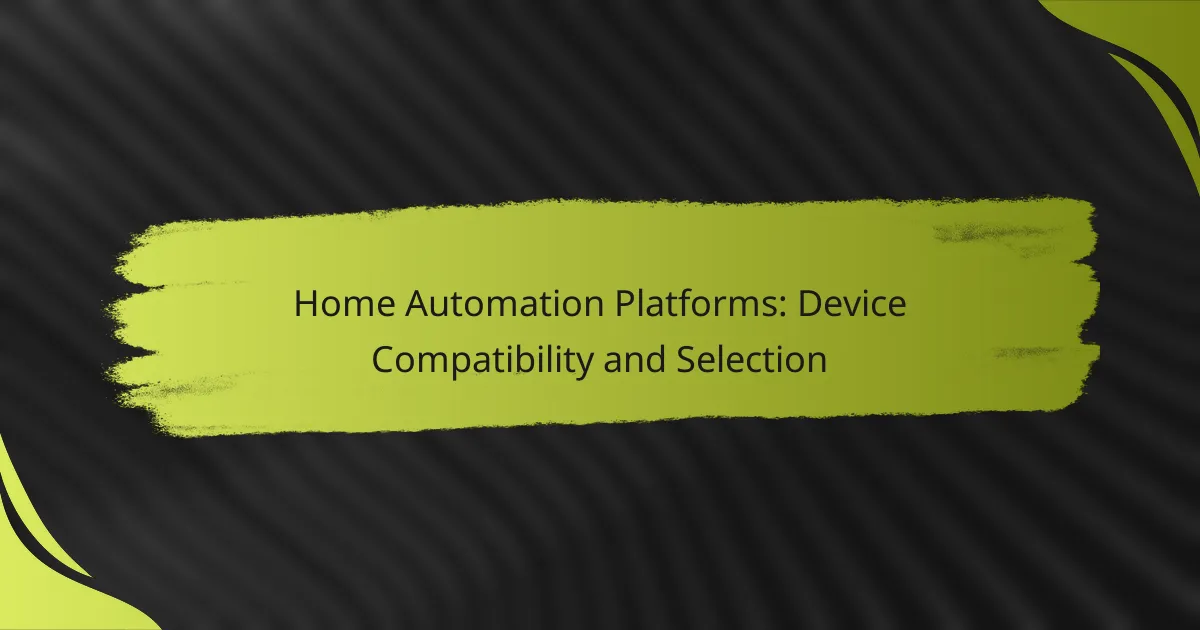Home automation platforms provide users with the ability to control a variety of smart devices, enhancing convenience and security in daily life. With options like Google Nest, Amazon Alexa, and Apple HomeKit, each platform offers distinct features and varying levels of device compatibility. When selecting a platform, it’s essential to consider factors such as user interface, ecosystem integration, and the range of supported devices to ensure a seamless smart home experience.

Which home automation platforms are compatible with devices in India?
Several home automation platforms are compatible with devices in India, allowing users to control smart home devices seamlessly. The most popular platforms include Google Nest, Amazon Alexa, Apple HomeKit, Samsung SmartThings, and Wink Hub, each offering unique features and device compatibility.
Google Nest compatibility
Google Nest supports a wide range of smart devices, including lights, thermostats, cameras, and speakers. Many popular brands, such as Philips Hue and TP-Link, are compatible, making it easy to integrate various devices into your home ecosystem.
When selecting devices for Google Nest, ensure they are labeled as “Works with Google Assistant” to guarantee compatibility. This platform is particularly strong in voice control capabilities, allowing users to manage their devices hands-free.
Amazon Alexa compatibility
Amazon Alexa is compatible with a vast array of smart home devices, including smart plugs, lights, and security systems. Brands like Ring, Ecobee, and WeMo offer products that work seamlessly with Alexa.
To maximize compatibility, look for devices that feature “Works with Alexa” branding. Alexa’s extensive ecosystem also allows for the creation of routines, enabling users to automate multiple devices with a single command.
Apple HomeKit compatibility
Apple HomeKit is designed for users within the Apple ecosystem, offering compatibility with devices that support HomeKit technology. Popular brands include Philips Hue, August, and Logitech, which provide a range of smart lighting and security options.
When choosing HomeKit-compatible devices, check for the “Works with Apple HomeKit” label. HomeKit emphasizes security and privacy, making it a solid choice for users concerned about data protection.
Samsung SmartThings compatibility
Samsung SmartThings supports a diverse range of smart home devices, including sensors, cameras, and appliances. It works well with brands like Philips Hue, Arlo, and SmartThings’ own devices, providing a comprehensive smart home solution.
For optimal performance, ensure devices are listed on the SmartThings compatibility page. SmartThings also allows for automation and integration with other platforms, enhancing its versatility.
Wink Hub compatibility
Wink Hub offers compatibility with various smart home devices across multiple brands, including Lutron, Nest, and Philips Hue. This platform is designed to unify different protocols, such as Z-Wave and Zigbee, making it easier to manage devices from different manufacturers.
When using Wink Hub, check the compatibility list on their website to confirm that your devices will work together. Wink’s user-friendly app allows for easy setup and control of your smart home devices.

How to choose the right home automation platform?
Choosing the right home automation platform involves assessing device compatibility, user interface, ecosystem integration, and pricing models. Prioritize platforms that support a wide range of devices and offer a user-friendly experience to ensure seamless automation in your home.
Assessing device compatibility
Device compatibility is crucial when selecting a home automation platform. Ensure that the platform supports a variety of devices, including smart lights, thermostats, cameras, and locks from different brands. Check for compatibility with popular standards like Zigbee, Z-Wave, and Wi-Fi.
To evaluate compatibility, create a list of your existing devices and verify their support on the platform’s website. Many platforms provide compatibility lists or databases to help you make informed decisions.
Evaluating user interface
A user-friendly interface significantly enhances your experience with a home automation platform. Look for platforms that offer intuitive navigation, easy setup, and customizable dashboards. A good interface should allow you to control devices quickly and efficiently.
Consider trying out the platform’s mobile app or web interface before committing. Many platforms offer demo versions or trial periods, allowing you to assess usability and determine if it meets your needs.
Considering ecosystem integration
Ecosystem integration refers to how well a home automation platform works with other smart home devices and services. Choose a platform that easily integrates with popular ecosystems like Google Assistant, Amazon Alexa, or Apple HomeKit for enhanced functionality.
Evaluate the platform’s ability to connect with third-party services and devices. A well-integrated system can provide automation routines that enhance convenience and efficiency in your daily life.
Analyzing pricing models
Pricing models for home automation platforms can vary significantly. Some platforms offer free basic services with optional premium features, while others may require a subscription for full functionality. Understand the costs associated with hardware, software, and any ongoing fees.
Compare pricing structures to determine the best value for your needs. Consider both initial setup costs and long-term expenses, such as subscription fees or additional device purchases, to ensure your chosen platform fits your budget.

What are the key features of popular home automation platforms?
Popular home automation platforms typically offer features such as voice control, remote access, automation scheduling, and enhanced security. These functionalities allow users to manage their smart devices efficiently and create a seamless living environment.
Voice control capabilities
Voice control is a crucial feature in home automation, enabling users to operate devices hands-free using voice commands. Platforms like Amazon Alexa, Google Assistant, and Apple HomeKit support a wide range of devices, making it easy to control lights, thermostats, and security systems with simple phrases.
When selecting a platform, consider the variety of voice assistants it supports, as compatibility can vary. Ensure that your preferred devices are compatible with the chosen voice control system to maximize convenience.
Remote access features
Remote access allows users to control their home automation systems from anywhere using a smartphone or tablet. This feature is essential for monitoring security cameras, adjusting thermostats, or turning lights on and off while away from home.
Look for platforms that offer mobile apps with user-friendly interfaces and reliable connectivity. Some platforms may also provide web access, enhancing flexibility in managing your home automation system.
Automation and scheduling options
Automation and scheduling features enable users to set routines for their devices, enhancing convenience and energy efficiency. For instance, you can program lights to turn on at sunset or set the thermostat to adjust temperatures based on your daily schedule.
When evaluating platforms, check for customizable automation options and the ability to create complex triggers that respond to various conditions, such as time of day or occupancy. This flexibility can significantly improve your home’s functionality.
Security features
Security features are vital in home automation, providing peace of mind through surveillance and alerts. Many platforms integrate with smart locks, cameras, and motion sensors, allowing users to monitor their homes in real-time and receive notifications of unusual activity.
Ensure the platform you choose offers robust security options, such as end-to-end encryption and two-factor authentication. Additionally, consider systems that allow for easy integration with existing security devices to enhance your home’s safety.

What are the benefits of using home automation platforms?
Home automation platforms offer numerous advantages, including improved energy efficiency, enhanced security, and increased convenience. These systems allow users to control various devices remotely, leading to smarter management of home resources and greater peace of mind.
Increased energy efficiency
Home automation platforms can significantly enhance energy efficiency by allowing users to monitor and control their energy consumption. For example, smart thermostats can adjust heating and cooling based on occupancy, potentially reducing energy bills by 10-30%.
Additionally, automated lighting systems can turn off lights in unoccupied rooms or adjust brightness based on natural light levels. This not only saves energy but also extends the lifespan of bulbs, making it a cost-effective solution.
Enhanced home security
Security is a major benefit of home automation platforms, which can integrate various devices like cameras, alarms, and smart locks. Users can receive real-time alerts on their smartphones if unusual activity is detected, allowing for immediate action.
Moreover, automated systems can simulate occupancy by controlling lights and appliances, deterring potential intruders. Many platforms also allow for remote monitoring, giving homeowners peace of mind while away from home.
Improved convenience
Home automation platforms streamline daily tasks, enhancing overall convenience. Users can control multiple devices with a single app or voice command, simplifying routines such as adjusting the thermostat or turning off lights.
For instance, setting up automation routines can allow for a “good morning” scenario that gradually brightens lights and starts the coffee maker at a designated time. This level of convenience can save time and reduce daily stress.
Customization options
Customization is a key feature of home automation platforms, allowing users to tailor settings to their preferences. Most systems support a variety of devices, enabling users to create unique combinations that suit their lifestyle.
For example, users can set specific schedules for devices or create scenes that adjust multiple settings at once, such as dimming lights and locking doors at bedtime. This flexibility ensures that the system meets individual needs and adapts as those needs change.

What are the common challenges in selecting home automation platforms?
Selecting a home automation platform can be challenging due to various factors, including device compatibility, user interface complexity, and integration capabilities. Understanding these challenges helps consumers make informed decisions that suit their specific needs.
Device compatibility issues
Device compatibility is a primary concern when choosing a home automation platform. Many platforms support a limited range of devices, which can restrict your options for smart home products. It’s essential to check whether the devices you already own or plan to purchase are compatible with the platform you are considering.
Different platforms may use various communication protocols, such as Zigbee, Z-Wave, or Wi-Fi, which can lead to integration issues. For instance, if you have Zigbee devices, ensure the platform supports this protocol to avoid connectivity problems. Researching compatibility lists or user reviews can provide insights into potential issues.
To mitigate compatibility challenges, consider platforms that offer broad support for multiple brands and devices. Look for platforms that provide a unified app experience, allowing you to control various devices seamlessly. This can save you time and frustration when managing your smart home ecosystem.
